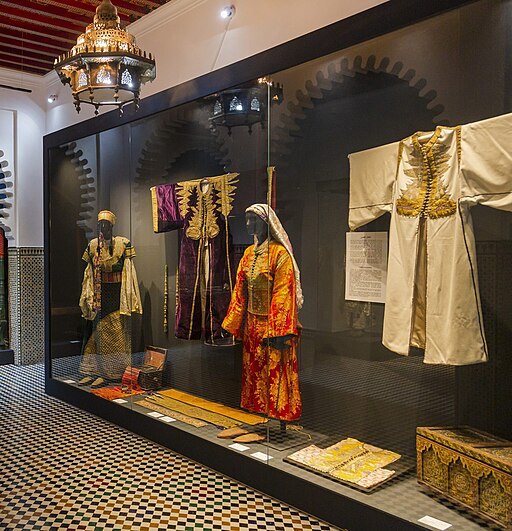 Tetouan kaftan, displayed in the Bab Oqla Museum, Tetouan.A current highlight from the TRC Collection (TRC 2023.0531)) is this Moroccan kaftan, dating from the late 19th or early 20th century. It is made out of Syrian satin silk and beautifully embroidered with gold and silver threads.
Tetouan kaftan, displayed in the Bab Oqla Museum, Tetouan.A current highlight from the TRC Collection (TRC 2023.0531)) is this Moroccan kaftan, dating from the late 19th or early 20th century. It is made out of Syrian satin silk and beautifully embroidered with gold and silver threads.
This type of kaftan used to be worn by women in the Tétouan region (northeastern Morocco) and is thus often referred to as a “Tétouan kaftan” (Caftan de Tétouan).
This style, especially with its large sleeves, is rarely worn by younger generations. It may originally have been worn together with other items of clothing, such as an embroidered bolero that was cinched at the waist with a belt.

These refined kaftans were normally made out of velvet, wool or, as in this case, fine silk, and were worn on festive occasions. Kaftans were originally a popular garment of the Persian and Ottoman Empires, before becoming an important piece of Moroccan traditional clothing around the 16th and 17th century, for both men and women.
The type of gold (or metal) embroidery on this piece is known as Sqalli and is said to have originated in the Jewish district of Tétouan and Fes.
The triangular motifs that are embroidered on the front of the kaftan bestow the name of Khanjar (or khenjar) to this type of coat pattern, a word that translates as “dagger” (in reference to the pointed shape of the decorative patterns).

So, while the cloth could be from Syria, the striped material resembles Ottoman pieces (Syria was part of the Ottoman Empire at the time), while the design and embroidery of the kaftan are Moroccan; a blend of culture and history.
Augusta de Gunzbourg, TRC curator, 5 November 2025










